Chromosomes, genes and proteins:
- Identify the correctly labelled structures.
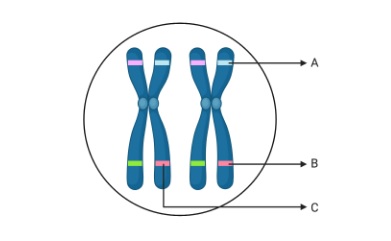
- B,and C are alleles of the same gene.
- B, and C, are both located at the same place on a pair of homologous chromosomes, and therefore represent alleles of the same gene.
Identify the correctly labelled structures.
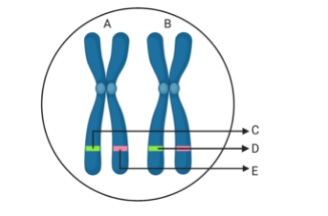
- C and D, are alleles of the same gene
- C and D, are located at identical positions on homologous chromosomes. They represent two alleles of a gene.
- A and B, are homologous chromosomes
- A, and B are a pair of homologous chromosomes that carry alleles of the same genes.
- Each parent cell carries two chromosomes with different alleles of the same gene – A and a. According to the chromosomal theory of inheritance, which of the following statements would be true?
- Every gamete has a 50% chance of receiving allele A
- The theory states that chromosomes obey the law of segregation. This means that every gamete has an equal probability of receiving the A allele.
- Every gamete has a 50% chance of receiving allele a
- The theory states that chromosomes obey the law of segregation. This means that every gamete has an equal probability of receiving the a allele.
- Every gamete has a 50% chance of receiving allele A
- In sheep, the sleepy(S) trait is dominant over the spirited(s) trait. Which of the following statements correctly describes why sleepy sheep express their phenotype?
- Sleepy sheep have at least one sleepy allele.
- Dominant traits express even if only one allele is present (Ss).
- Sleepy sheep have at least one sleepy allele.
- In sheep, the boring B trait is dominant over the cool b trait. Which of the following statements correctly describes why boring sheep express their phenotype?
- Boring sheep have at least one boring allele.
- Dominant traits express even if only one allele is present (Bb)
- Boring sheep have at least one boring allele.
- There are 10 chromosomes with 1000 genes in a gamete of a particular organism. Assume that the genes are equally distributed, such that each chromosome carries 100 genes. How many chromosomes and genes would there be in a somatic cell of the same organism?
- 20 chromosomes, 2000 genes
- Gametes are formed through meiosis, which results in reduction of genetic material by half. Therefore, chromosome and gene numbers in somatic cells will be twice that in gametes.
- 20 chromosomes, 2000 genes
- Each parent cell carries two chromosomes with different alleles of the same gene A and a. Each gamete has an equal chance of receiving either allele. According to the chromosome theory of inheritance, this aligns with one of Mendel’s laws. Which of Mendel’s laws describe this phenomenon?
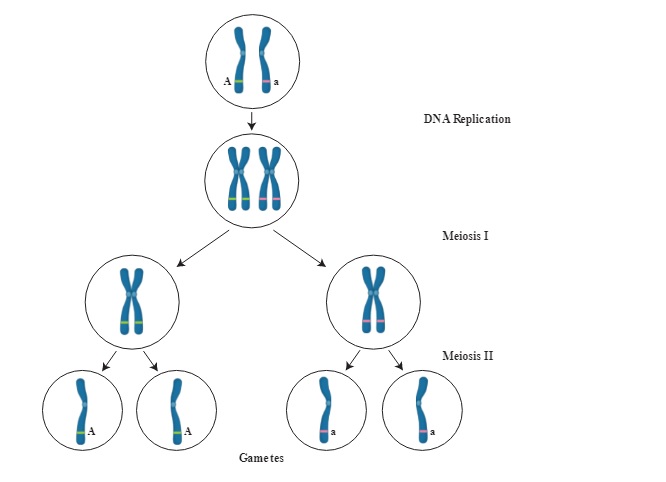
- Law of segregation
- This law describes how a pair of traits separate and are inherited individually. Thus, every gamete can receive either one of the two alleles.
- Early critics of the chromosome theory argued that individuals have far more traits than chromosomes. We now know that this can be explained by the fact that multiple genes are located on a single chromosome. Which of the following statements further describes the relationship between Mendel’s traits and chromosomes?
- Offspring receive one half of their chromosomes and traits from each parent.
- Each parents donates one set of chromosomes (carrying traits or genes) to their offspring.
- Offspring receive one half of their chromosomes and traits from each parent.
- The image below depicts two different outcomes of meiotic division in a cell. Which of the following statements correctly describes the illustrated phenomenon?
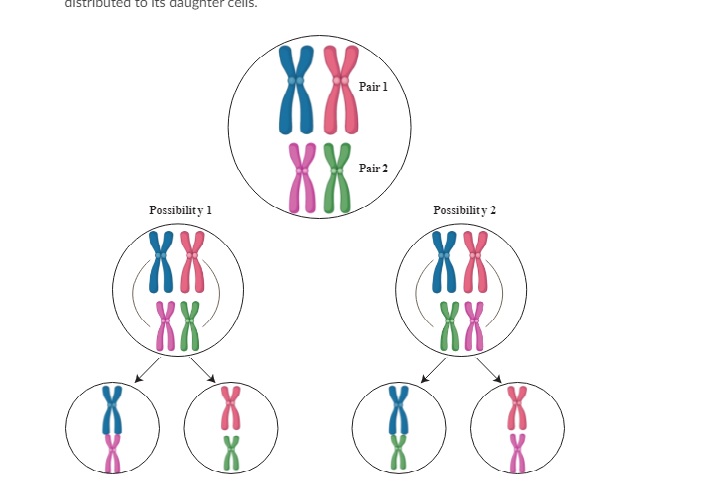
- Which of the following statements correctly describes the illustrated phenomenon?
- A set of homologous chromosomes can be inherited independent of each other.
- The law of independent assortment can be seen in chromosomes as well. Each member of pairs 1 and 2 can be sorted independently into daughter cells.
- A set of homologous chromosomes can be inherited independent of each other.
- Early critics of the chromosome theory argued that individuals have far more traits than chromosomes. We now know that this can be explained by the fact that multiple genes are located on a single chromosome.
- Which of the following statements further describes the relationship between Mendel’s traits and chromosomes?
- Offspring receive one half of their chromosomes and traits from each parent. Each parents donates one set of chromosomes (carrying traits or genes) to their offspring.
- Which of the following statements further describes the relationship between Mendel’s traits and chromosomes?
- The image below depicts two different crosses. The letters represent genes and their alleles, located on homologous pairs of chromosomes.
- In which case is the parental gene combination (A+B,c+d,etc) more likely to be retained by the offspring?
- Cross 1
- Genes A and B are located near each other, and are therefore tightly linked. Since recombination is more probably in loosely linked genes, cross 1 is likely to retain parental gene combinations
- Cross 2
- Genes C and, D are located far apart, and therefore loosely linked. Thus recombination will be more probable in cross 2 and the offspring will carry non-parental combinations like C, +d or c+D
- Cross 1
- In which case is the parental gene combination (A+B,c+d,etc) more likely to be retained by the offspring?

- The table below lists a set of gene pairs and their frequency of recombination.
| Gene pair | % Recombination |
| A and B | 80 |
| B and C | 10 |
| C and A | 50 |
- Frequency of recombination depends inversely on the distance between genes. Therefore, the distance between (A and B) >(A and C) >(B and C)Bottom of Form

- In Drosophila melanogaster flies, sex is determined by the presence of X chromosome – females have two (X, X) and males have one (X,Y). Morgan discovered a recessive white eye allele that was expressed by some males, but very rarely by females. Based on these observations, he concluded that the gene for eye color was present on the X chromosome.
- Why do males express the recessive trait more often than females?
- Males need only one copy of the recessive allele to express it.
- Since males have only one X chromosome, a single copy of the recessive allele will be enough for it to express.
- Males need only one copy of the recessive allele to express it.
- Why do males express the recessive trait more often than females?
- In Drosophila melanogaster flies, sex is determined by the presence of X chromosomes – females have two (XX) and males have one (XY). Morgan noticed that there were contrasting alleles for eye color in these flies – red (dominant) and white (recessive). A cross between a white-eyed female and a red-eyed male produced the following outcome: He concluded that the gene for eye color was present on the X chromosome.
- Why do males express the recessive trait more often than females?
- Males need only one copy of the recessive allele to express it.
- Since males have only one X chromosome, a single copy of the recessive allele will be enough for it to express.
- Males need only one copy of the recessive allele to express it.
- Which of the following statements could explain Morgan’s observations in the offspring?
- Males will only inherit the recessive allele, and therefore will always have white eyes.
- Males will inherit the X chromosome with the recessive allele from the mother, and the Y chromosome from the father. They will always have white eyes.
- Males will only inherit the recessive allele, and therefore will always have white eyes.
- Why do males express the recessive trait more often than females?
- The image below depicts the locations of genes A – E on a chromosome. Arrange genes A- D in descending order of linkage strength to gene E.
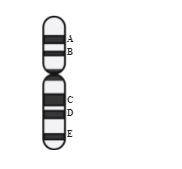
The genes A, B, C all lie on this chromosome. Genes B and C are located closer to each other than to A.
Therefore, when crossing over of homologous chromosomes occurs during meiosis, recombination is more likely to occur between genes that are farther apart.
B and C remain tightly linked even after crossing over.
D is the closest to E while gene A is the farthest away. Therefore, the strength of linkage in descending order will be D>C>B>A.
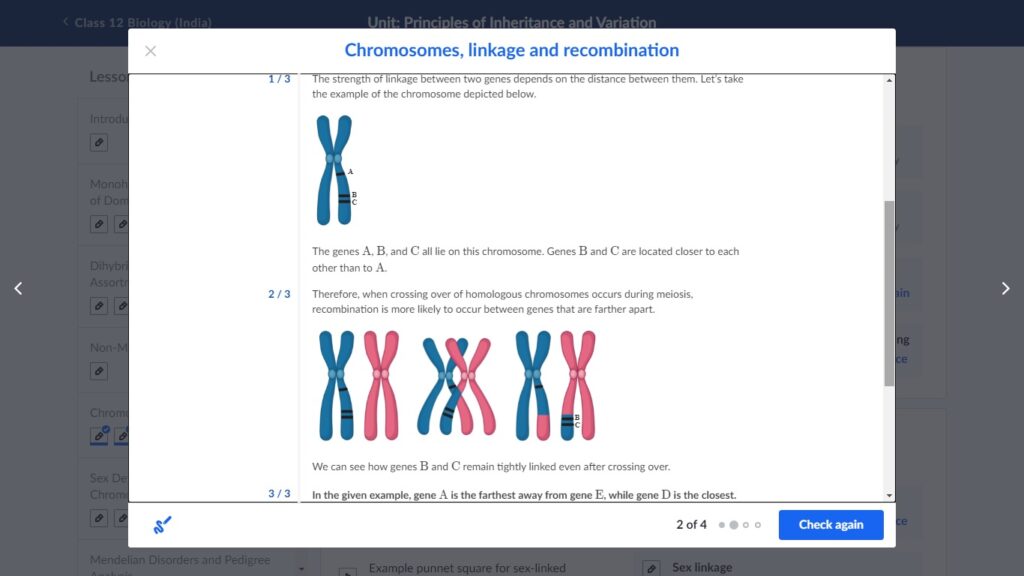
Gene mapping and recombination frequency:
Genes A, B, G, and H are located on the same chromosome. The distances between the genes are below:
| Relationship | Map Unit Distance |
| A – H | 18 |
| A – B | 10 |
| B – H | 8 |
| A – G | 2 |
| H – G | 20 |
What is the most likely order of the genes on the chromosome?– HBAG
Genes D, E, F, and G are located on the same chromosome. The distances between the genes are below:
| Relationship | Map Unit Distance |
| G – D | 11 |
| G – E | 7 |
| G – F | 22 |
| E – F | 15 |
| D – E | 4 |
What is the order of the genes on the chromosome? – EGDF
A scientist crosses a GgTt pea plant with a ggtt pea plant and the following offspring are produced:
| Phenotype | Number of Offspring |
| Green, tall | 723 |
| Yellow, short | 749 |
| Green, short | 48 |
| Yellow, tall | 46 |
What is the percent recombination frequency for this cross?
Round to nearest whole number.
To find the recombination frequency (RF), we need to use the following equation:
RF = recombinants/total offsprings * 100%
where “recombinants” are offspring that do not show the parental phenotype.
In this case, the parental phenotypes are green/tall (GgTt) and yellow/short (ggtt) so we know the recombinant offspring are green/short (48), and yellow/tall (46). Plugging these numbers into the equation for RF gives:
RF = recombinants/ total offsprings * 100%
= 48+46 / 723+749+48+56 * 100% = 94/1566 * 100%
= 6%
Sex Determination in humans:
- What are the characteristics of human sex chromosomes?
- Females are determined by a pair of similar chromosomes. Female human beings have two X chromosomes (XX)
- Males are determined by a pair of dissimilar chromosomes. Human males have one X and one Y chromosomes (XY)
- Which of the following statements about sex determination in humans is true?
- Sex of the child is determined by the genetic content of gametes.
- Gametes carry X or Y sex chromosomes, which determine the sex of the child upon fertilization.
- Sahil and Neha are expecting their first child in a few months. Both of them are hoping for a son. What percentage chance is that their child will be a son?
- 50 percent
- There is a 50 percent chance that the sperm that fertilizes the egg will contain either an X or Y chromosome. Since the egg itself always contains an X itself, there will always be a 50 percent chance of an XY zygote (a boy) forming.
- Sex in humans is determined by genetic material carried in gametes.
- The sex of a human baby is determined by the chromosomes present in gametes. The zygote receives one sex chromosome from each gamete, which determines it as either XX or XY.
- 50 percent
In Drosophila flies, red eyes (R) are dominant to white eyes (r) and normal wings (W) are dominant to vestigial wings (w).
A scientist performs a test cross by mating a RrWw fly with an rrww fly to produce the following offspring:
| Phenotype | Number of Offspring |
| Red-eyed, normal wings | 368 |
| Red-eyed, vestigial wings | 56 |
| White-eyed, vestigial wings | 336 |
| White-eyes, normal wings | 40 |
What is the percent recombination frequency for this cross?
Round to nearest whole number.
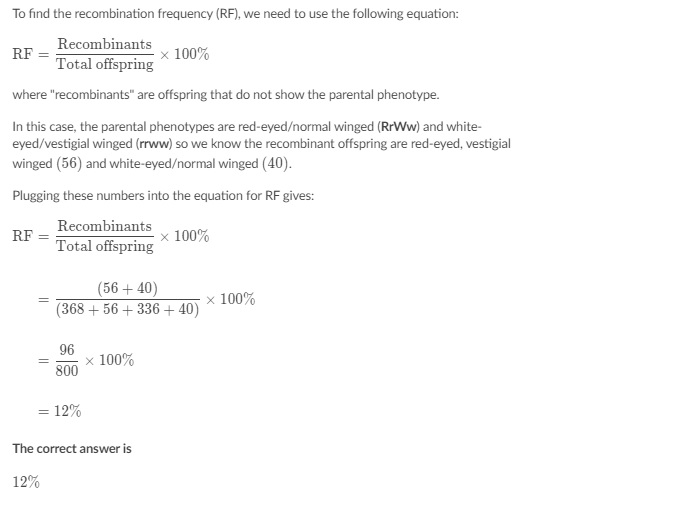
Genes A, B, C, and D are located on the same chromosome. The recombination frequencies (RF) are as follows:
| Relationship | RF |
| A – B | 10% |
| A – C | 25% |
| A – D | 23% |
| B – C | 15% |
| C – D | 48% |
What is the most likely order of the genes on the chromosome? – CBAD
Sex linkage and traits:
- In Drosophila flies, eye color is sex-linked. The allele for red eyes (X^W) is dominant to the allele for white eyes (X^w). A male fly with red eyes X^W Y and a carrier female X^W, X^w are mated. What is the probability that the female offspring will have white eyes?
- 0%
- If we complete the cross, we find that the female offspring can be either X^WX^W or X^WX^w. In order for a female fly to have white eyes, it must have a genotype of X^wX^w.
- Of the two possible female genotypes, 0/2 or 0% have this genotype. This means that 0/2 or 0% the females will have white eyes.
- Remember that this problem asks ONLY for the probability of females having white eyes, not all of the offspring
- 0%
- In the fruit fly Drosophilia, eye color is sex-linked. The allele for red eyes is dominant (XW) and the allele for white eyes is recessive. A scientist crosses two red-eyed flies and notice that half of their male offspring have white eyes. What are the genotypes of the parents?
- XWXw and XwY
- For the father to have a normal phenotype, he must have a genotype XwY,For the mother to give a white allele to her sons, she must have a genotype of XWXw.
- XWXw and XwY
- Ocular albinism is an X-linked recessive trait that causes a lack of pigmentation in the eyes. A father with ocular albinism and mother without the trait have a daughter. What is the percent chance that the daughter will have ocular albinism?
- 0% –
- In order for a daughter to be affected, she must be XaXa. There is a 0 in 4 chance that they will produce a child with this genotype.
- 0% –
- Cat coat color is an X-linked trait. Calico cats typically have patches of black, white, and orange on their coats as a result of X-inactivation. Most calico cats are female, but rarely a male calico will be born into a litter. Which of the following could explain calico coat color in a male kitten?
- The male kitten has a genotype of XXY.
- XXY individuals develop as outwardly male, but since only one X can be active in each cell, one of the two X chromosomes will be randomly inactivated during his development.
- The male kitten has a genotype of XXY.
- Hunter syndrome is a progressively debilitating recessive disorder that is inherited on the X chromosome. A father without Hunter syndrome and an unaffected carrier mother have a child. Which of the following statements is true?
- No daughter they have will be affected.
- In order for a daughter to be affected, she must be XhXh. There is a 0 in 4 chance that they will produce a child with this genotype.
- No daughter they have will be affected.
- Male-pattern baldness is an X-linked recessive trait, labelled X^ {b} with the dominant normal hair gene being X^ B. A father with the genotype X^ {B}Y and a mother with the genotype X^ {b} X^b have a son. What is the percent chance that the son will inherit male-pattern baldness?
- 100%
- A male offspring always inherits his X-chromosome from his mother.
- Because the mother’s genotype is X^ {b}X^ {b} she can only contribute an X^ {b} to her sons. This means that all of the sons will be X^ {b}Y, getting the baldness gene from the mother and the Y-chromosome from the father.
- 100%
Punnett squares and probability:
- In corn, smooth kernels (K) are dominant to wrinkled kernels (k). A farmer crosses two corn plants that are heterozygous for kernel texture. What are the odds that the offspring will have smooth kernels?
- 3/4
- The cross results in one KK (smooth kerneled), two Kk (smooth kerneled), and one kk (wrinkled kerneled) offspring.
- A cross between two heterozygotes will result in a 3:1 mix of offspring.
- Because the parents are heterozygous, there will be a mix of smooth and wrinkled kerneled offspring.
- 3/4
- In a pea plant, tall (T) is dominant to short (t), and green peas (G) are dominant to yellow peas (g). A tall plant with yellow peas (Ttgg) is crossed with a short plant with green peas (ttGg). Both the T and G traits assort independently from one another. What is the chance that the offspring will be short with yellow peas?
- 1/4
- 4 of the possible 16 genotypes will be short plants with yellow peas (ttgg). 4/16 = 1/4
- The cross results in the following offspring:
- Four TtGg (tall with green peas)
- Four ttGg (short with green peas)
- Four Ttgg (tall with yellow peas)
- Four ttgg (short with yellow peas)
- We are looking only for short plants with yellow peas.
- The cross results in the following offspring:
- 4 of the possible 16 genotypes will be short plants with yellow peas (ttgg). 4/16 = 1/4
- 1/4
- In monkeys, being playful (P) is dominant to being paranoid (p). A heterozygous female is crossed with a homozygous dominant male. What are the possible genotypes of their offspring?
- PP and Pp
- As a result of the parental cross (Pp x PP), two distinct offspring genotypes are possible:
- There is a 50% chance of the offspring being PP (playful) and 50%50, percent chance of the offspring being Pp (playful).
- As a result of the parental cross (Pp x PP), two distinct offspring genotypes are possible:
- PP and Pp
- In snakes, being rude (R) is dominant to being respectful (r), and being sneaky (S) is dominant to being sincere (s). A female snake that is homozygous recessive for both the r and s trait is mated with a male snake that is homozygous dominant for both traits (R and S). Both the R and S traits assort independently from one another. What is the probability that they will have an offspring that is respectful and sincere?
- 0/16
- 0 of the possible 16 genotype combinations will result in the respectful and sincere phenotype.
- All 16 offspring genotype possibilities will have the dominant R and S alleles. This will mask the expression of both recessive phenotypes, thus making it impossible for any of the offspring to be respectful and sincere.
- In the dihybrid rrss x RRSS cross, none of the phenotype combinations arise in a 9/16 ratio, so this probability isn’t possible for the respectful and sincere phenotype combination.
- 0 of the possible 16 genotype combinations will result in the respectful and sincere phenotype.
- 0/16
- In chickens, the allele for a pea comb (A) is dominant to the allele for a single comb (a). A mother with the genotype Aa and a father with the genotype Aa produce an offspring. What is the percent chance that the offspring will have a single comb?
- 25%
- The cross results in one AA (pea comb), two Aa (pea comb), and one aa (single comb) offspring.
- Because the parents are heterozygous, there will be a mix of pea combed and single combed offspring.
- A cross between two heterozygotes will result in a 3:1 mix of offspring.
- Because the parents are heterozygous, there will be a mix of pea combed and single combed offspring.
- Single combs are recessive to pea combs and would not make up 75% of the offspring.
- 25%
- In cats, being awesome (A) is dominant to being average (a), and being bashful (B) is dominant to being boring (b). A male cat that is homozygous dominant for the A trait and heterozygous for the B trait is mated with a female cat that is homozygous recessive for both. Both the A and B traits assort independently from one another. What is the probability that they will have an offspring who is heterozygous for both traits?
- 50%
- 8 of the possible 16 genotypes will be heterozygous for both the A and B traits (AaBb). 8/16 AaBb = 1/2 =50%
- The cross results in the following offspring:
- Eight AaBb (awesome, bashful)
- Eight Aabb (awesome, boring) but only looking for AaBb (awesome, bashful) offspring.
- 50%
- In horses, black coloring (B) is dominant, and chestnut coloring (b) is recessive. A homozygous black horse crosses with a chestnut horse. What percentage of offspring are expected to be chestnut?
- 0%
- The cross results in only Bb (black) offspring. It does not produce any bb (chestnut) offspring. 0/4 bb = 0% chestnut offspring
- Because one parent is homozygous dominant and the other is homozygous recessive, only Bb offspring are produced.
- In order for any homozygous recessive offspring to be produced, each parent must be able to donate a recessive allele.
- 0%
- In dogs, being clumsy (C) is dominant to being cool (c), and being dazzling (D) is dominant to being docile (d). A female dog that is heterozygous for both the C and D trait is mated with a male dog that is also heterozygous for both traits. Both the C and D traits assort independently from one another. What is the probability that they will have an offspring that is clumsy and dazzling?
- 9/16
- 9 of the possible 16 genotype combinations will result in the clumsy and dazzling phenotype:
- One CCDD (clumsy, dazzling)
- Two CcDD (clumsy, dazzling)
- Two CCDd (clumsy, dazzling)
- Four CcDd (clumsy, dazzling)
- In the dihybrid CcDd x CcDd cross, the phenotype combination that arises in 1/16 ratio is cool and docile, but we are looking for clumsy and dazzling.
- We need genotype combinations with at least one dominant C allele and one dominant D allele to get the clumsy and dazzling phenotype.
- In the dihybrid CcDd x CcDd cross, the phenotype combinations that arise in 3/16ratio are cool and dazzling OR clumsy and docile, but we are looking for clumsy and dazzling.
- In the dihybrid CcDd x CcDd cross, none of the phenotype combinations arise in 1/4 ratio.
- 9 of the possible 16 genotype combinations will result in the clumsy and dazzling phenotype:
- 9/16
- In buffalo, being boring (B) is dominant to being busy (b). A true-breeding, busy male is crossed with a true-breeding, boring female. What are the possible genotypes of their offspring?
- Only Bb
- As a result of the parental cross (bb x BB), only one distinct offspring genotype is possible: There is a 100% chance of the offspring being Bb (boring)
- As a result of the parental cross (bb x BB), the possible offspring genotype(s) must have at least one dominant B allele and one recessive b allele.
- Only Bb
- In rabbits, brown fur (B) is dominant to white fur (b) and short fur (H) is dominant to long fur (h). A brown, long-furred rabbit (Bbhh) is crossed with a white, short-furred rabbit (bbHh). Both the B and H traits assort independently from one another. What percentage of the offspring will be brown with long fur?
- 4 of the possible 16 genotypes will be brown with long fur (Bbhh).
- 4/16 Bbhh = ¼ = 25%
- The cross results in the following offspring:
- Four BbHh (brown, short fur)
- Four bbHh (white, short fur)
- Four Bbhh (brown, long fur)
- Four bbhh (white, long fur)
- We are looking for only brown, long-furred offspring.
- The cross results in the following offspring:
- 4/16 Bbhh = ¼ = 25%
- 4 of the possible 16 genotypes will be brown with long fur (Bbhh).
- In leopards, being shy (S) is dominant to being sassy (s), and being timely (T) is dominant to being tardy (t). A female leopard that is heterozygous for both the S and T trait mates with a male leopard that is also heterozygous for both traits. Both the S and T traits assort independently from one another. What is the probability that they will have an offspring that is sassy and timely?
- 18.75%
- 3 of the possible 16 genotype combinations will result in the sassy and timely phenotype:
- One ssTT (sassy, timely)
- Two ssTt (sassy, timely)
- 3/16 = 18.75%
- In the dihybrid SsTt x SsTt cross, the sassy and timely phenotype combination is indeed a possibility in the offspring, and thus, must have a probability greater than 0%, percent. We need to find genotype combinations with two recessive s alleles and at least one dominant T allele to get the sassy and timely phenotype.
- In the dihybrid SsTt x SsTt cross, the phenotype combination that arises 6.25% of the time is sassy and tardy, but we are looking for sassy and timely phenotype.
- 3 of the possible 16 genotype combinations will result in the sassy and timely phenotype:
- 18.75%
- Sickle-cell anemia is a recessive trait in humans. In order to express the disease, an affected individual must inherit two recessive alleles (ss). What is the probability that the offspring of two heterozygous parents will also be heterozygous?
- 1/2
- As a result of the parental cross (Ss x Ss), a proportion of 2/4 offspring has a chance to be heterozygous (Ss). When simplified, 2/4=1/2
- As a result of the parental cross (Ss x Ss), a probability greater than 1/4 of the offspring has a chance to be heterozygous (Ss).
- 1/2
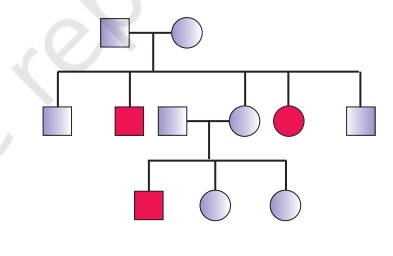

- Hemophilia is an X-linked recessive trait. A non-hemophiliac father and a hemophiliac mother have a son. What is the percent chance that the son will be a hemophiliac?
- 100%
- A son will always inherit his one X chromosome from his mother. Because the mother’s genotype XhXh can only contribute an Xh to her sons.
- 100%
- Hemophilia is an X-linked recessive condition in which blood does not clot properly. Queen Victoria of England had one allele for hemophilia. Most of her male descendants had the disorder, but few females had it. Why did hemophilia occur more frequently in Queen Victoria’s male descendants?
- Only one copy of the X chromosome is found in cells of males, but two copies are found in cells of females.
- Hemophilia is encoded by a gene on the X-chromosome. Females (XX) carry two copies (one on each X), and males (XY) only carry one. Because males only have one X-chromosome, whatever allele is present on that single X-chromosome will be expressed.
- Only one copy of the X chromosome is found in cells of males, but two copies are found in cells of females.
- Color blindness is a sex‑linked recessive trait in humans. A woman who is a carrier for color blindness has children with a man who is color blind.
- Which of the following is true regarding their offspring?
- Any daughter is either color blind or a carrier.
- If we complete a Punnett square of the parents, we find that the female offspring can only be either X^BX^b(carrier) or X^bX^b (color blind).
- Which of the following is true regarding their offspring?
- Red-green colorblindness is a recessive X-linked trait in humans. Which of the following pairs of parents is most likely to produce a daughter with red-green colorblindness?
- A carrier mother and a colorblind father
- A carrier mother {X}^{B} {X}^{b} and a colorblind father {X}^{b} Y could each pass on a colorblind allele to their daughter.
- A carrier mother and a colorblind father
Pedigrees:
- The pedigree below tracks the presence of dimples through a family’s generation. Having dimples is an autosomal dominant trait. What is the phenotype of individual III-4?
- Dimples
- Because we are tracking dimples, shaded individuals represent those who have dimples.
- Dimples
- The pedigree below tracks the presence of dimples through a family’s generation. Having dimples is an autosomal dominant trait. If individuals II-1 and II-2 have a fourth child, what is the probability that the child will have dimples?
- 50%
- The genotypes that can produce dimpled children are DD or Dd.
- A cross between II-1 and II-2 would produce two boxes with dimpled offspring (Dd) and two boxes with non-dimpled offspring (dd).
- 50%
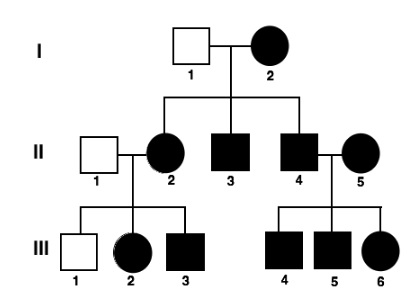
- The pedigree below tracks the presence of dimples through a family’s generation. Having dimples is an autosomal dominant trait. Which of the following individuals is correctly matched with its genotype?
- III-2 Dd
- Individual III-2 has dimples, meaning she must have 1 D allele. Her father does not have dimples, so he donates a d allele, giving her a genotype of Dd.
- III-2 Dd
- The pedigree below tracks the presence of dimples through a family’s generation. Having dimples is an autosomal dominant trait. If individuals II-1 and II-2 have a fourth child, what is the probability that the child will have dimples?
- 50%
- A cross between II-1 and II-2 would produce two boxes with dimpled offspring (Dd) and two boxes with non-dimpled offspring (dd).
- 50%
- The pedigree below tracks the presence of dimples through a family’s generation. Having dimples is an autosomal dominant trait. If individual III-3 married a woman who was heterozygous for dimples, what is the percent chance their children will have dimples?
- 75%
- This cross has a 3/4 chance of producing individuals that have at least one D allele. Because dimples D is dominant, these individuals will have dimples.
- 75%
- The pedigree below tracks the presence of dimples through a family’s generation. Having dimples is an autosomal dominant trait. Which of the following individuals is correctly matched with its genotype?
- III-2 Dd
- Individual III-2 has dimples, meaning she must have 1 D allele. Her father does not have dimples, so he donates a d allele, giving her a genotype of Dd.
- III-2 Dd
- Duchenne muscular dystrophy (DMD) is an X-linked recessive condition that causes rapid muscle degeneration. DMD occurs in approximately 1 in every 3500 males, but it rarely affects females. Which statement most accurately explains why DMD affects males more often than females?
- Males only have one copy of the X chromosome. DMD is encoded by a gene on the X-chromosome. Because males only have one X-chromosome, whatever allele is present on that single X-chromosome will be expressed.
- Duchenne Muscular Dystrophy (DMD) is an X-linked recessive trait that causes muscular weakness, deterioration of muscle tissue, and loss of coordination. The allele for DMD is represented by X^ d, and the normal allele is represented by X^D. Neither parent has DMD, but both of their sons express the trait.
- What are the genotypes of the parents?
- X^DX^d and X^DY
- What are the genotypes of the parents?
- The pedigree below tracks Duchenne Muscular Dystrophy (DMD) through several generations. DMD is an X-linked recessive trait. Based on the pedigree, which of the following is true?
- If individual III-1 marries an unaffected, non-carrier female, none of their offspring will have DMD.
- Individual III-1 is an unaffected male. If he mates with an unaffected, non-carrier female, there is no chance that the children will inherit the DMD allele.
- Individual II-3 is an affected male, so his genotype XdY
- Individual II-1 is an unaffected male. Because males only have one X chromosome, they cannot be carriers.
- Individuals II-4 and II-5 are both affected and have the recessive genotypes XdY, XdXd respectively. Any child they have will have DMD.
- If individual III-1 marries an unaffected, non-carrier female, none of their offspring will have DMD.

- The pedigree below tracks Duchenne Muscular Dystrophy (DMD) through several generations. DMD is an X-linked recessive trait. What is the genotype of individual II-2?
- XDXd
- In order for individual II-2 to produce an affected son, she must be a carrier for DMD.
- XDXd
- The pedigree above tracks Duchenne Muscular Dystrophy (DMD) through several generations. DMD is an X-linked recessive trait. If individual II-3 has a child with a carrier woman, what is the percent chance that the child will be a daughter with DMD?
- 25%
- In order for a daughter to be affected, she must have a genotype XdXd
- There is a 1 in 4 chance that they will produce a child with this genotype.
- 25%
- The pedigree below tracks Duchenne Muscular Dystrophy (DMD) through several generations. DMD is an X-linked recessive trait. If individuals I-1 and I-2 had another son, what is the chance that he would have DMD?
- 100%
- Because individual I-2 is affected, she can only pass on a recessive DMD allele to her sons. This means that all of her sons will have DMD.
- 100%
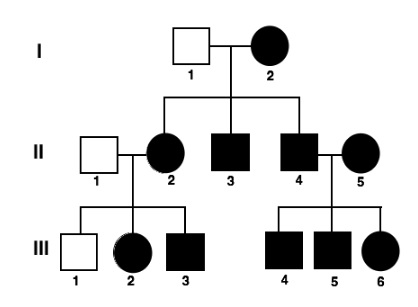
- The pedigree below tracks the presence of attached earlobes through a family’s generation. Having attached earlobes is an autosomal recessive trait. What is the genotype of individual II-3?
- Ee
- II-3 has a mother with attached earlobes ee so he must receive at least one recessive allele from her.
- Attached earlobes is autosomal, so the trait is not attached to the X chromosome.
- II-3 must have a heterozygous genotype because he has a mother with attached earlobes, but shows the dominant condition.
- I-1 is able to pass on a recessive allele to some of his offspring (II-2 and II-4), so he must have at least one recessive allele
- Ee

- The pedigree below tracks the presence of attached earlobes through a family’s generation. Having attached earlobes is an autosomal recessive trait. If individuals I-1 and I-2 had a fourth child, what is the chance that the child would have attached earlobes?
- 50%
- A cross between I-1 and I-2 would produce two offspring with unattached earlobes (Ee) and two offspring boxes with attached earlobes (ee).
- 50%
- If individual III-6 married a man who was homozygous for unattached earlobes, what is most likely to be true regarding their children?
- All of their children would have unattached earlobes.
- Individual III-6 has attached earlobes (ee). If she has children with a homozygous dominant man (EE), all of her children will be heterozygous and have unattached earlobes.
- All of their children would have unattached earlobes.
- The pedigree below tracks the presence of attached earlobes through a family’s generation. Having attached earlobes is an autosomal recessive trait. What is the genotype of individual I-1?
- Ee
- I-1 must have a heterozygous genotype because he is able to pass on a recessive allele to some of his offspring (II-2 and II-4).
- Ee
Non-mendelian inheritance:
- A black sheep is bred with a white sheep. All of their offspring have a phenotype of gray coats. What is the most likely pattern of inheritance for coat color in sheep?
- Incomplete dominance
- Since the offspring have an intermediate phenotype (in between the colors black and white i.e. gray), this is an example of incomplete dominance.
- Incomplete dominance is a pattern of heredity in which one allele is not completely dominant over another. This doesn’t occur in human blood type.
- Incomplete dominance
- In a species of birds, blue feathers (B) are incompletely dominant to the gene for white feathers (b). Individuals that are heterozygous (Bb) have blue-tipped feathers. A bird with blue-tipped feathers is crossed with a white bird. What is the chance that the offspring will have blue feathers?
- 0%
- This cross will only produce Bb and bb offspring.
- A Bb x bb cross will produce:
- 2/4 or 50%, Bb offspring
- 2/4 or 50%, bb offspring
- 0%
- In humans, the gene for curly hair (H) is incompletely dominant to the gene for straight hair (h). Individuals that are heterozygous (Hh) have wavy hair. Two wavy-haired heterozygous parents have a child. What is the likeliness that the child will have wavy hair?
- 1/2
- ¼ offspring will have curly hair (HH), 1/4 offspring will have straight hair (hh), and 2/4 will have wavy hair (Hh). 2/4 Hh = 1/2
- An Hh x Hh cross will produce:
- 1/4 HH offspring
- 2/4 Hh offspring
- 1/4 hh offspring
- Because the parents are heterozygous, both the curly and straight alleles will show up in the offspring.
- 1/2
- In humans, three alleles affect blood type. The A and B alleles are codominant and the O allele is recessive. Which of the following answer choices is true?
- The A and B alleles are codominant because both alleles are simultaneously expressed in the heterozygote.
- This is true because it would result in the AB blood type, a codominant genotype that results in the codominant phenotype of both A and B antigens simultaneously present on AB red blood cells.
- Codominance occurs when two alleles are simultaneously expressed in the heterozygote.
- Human blood type is an example of multiple allele inheritance.
- Multiple allele inheritance occurs when a gene is controlled by more than two alleles. The ABO blood type system involves three alleles, two of which will be inherited by the diploid offspring.
- The A and B alleles are codominant because both alleles are simultaneously expressed in the heterozygote.
- When white-coated cattle (W) are mated with red-coated cattle (R), the offspring are roan (WR), meaning their coats contain both white and red hairs. This is an example of codominance. A farmer breeds two roan cattle with one another. What is the chance that their offspring will be roan?
- 50%
- 1/4 of the offspring will be white (WW), 1/4 of the offspring will be red (RR), 2/4 OF the offspring will be roan (WR).
- 2/4 WR = 1/2 = 50%
- 50%
- A gene for corn has two alleles, one for yellow kernels and one for white kernels. A farmer mates yellow and white corn. All of the offspring have a nearly even mix of yellow and white kernels. Which type of inheritance most likely explains the relationship between the two alleles
- Codominance
- Because both alleles (yellow and white) are expressed, this is an example of codominance.
- Codominance
- In camellia flowers, petal color is controlled by codominance. When a red flower is crossed with a white flower, all of the offspring are covered in both red and white petals. A scientist crosses a red flower (RR) with a red-and-white (RW) flower. What are the predicted phenotypes of their offspring?
- 50% of the offspring will be red 50% of the offspring will be red-and-white
- 2/4 or 50% of the offspring will be red (RR) and 2/4 0r 50% of the offspring will be red-and-white (RW).
- All of the offspring will have red-and-white petals.
- A RR x RW cross will produce
- 2/4 0r 50%, RR offspring
- 2/4 0r 50%, RW offspring
- Because these flowers experience codominance, both colors will be expressed.
- 50% of the offspring will be red 50% of the offspring will be red-and-white
- When white-coated cattle (W) are mated with red-coated cattle (R), the offspring are roan (WR), meaning their coats contain both white and red hairs. This is an example of codominance. A farmer breeds two roan cattle with one another. What is the chance that their offspring will be roan?
- 50%
- 1/4 of the offspring will be white (WW), 1/4 of the offspring will be red (RR), 2/4 OF the offspring will be roan (WR). 2/4 WR = 1/2 = 50%
- A WR x WR cross will produce:
- 1/4 WW offspring
- 2/4, WR offspring
- 1/4, RR offspring
- 50%
- In humans, three alleles affect blood type. The A and B alleles are codominant, and the O allele is recessive. An AB blood type father has children with an A blood type mother (genotype AO). What are the chances that their children will have AB type blood?
- 25%
- 1/4 offspring will have the AB blood type
- An AB x AO cross will produce:
- ¼ AA offspring
- ¼ AB offspring
- ¼ AO offspring
- ¼ BO offspring
- An AB x AO cross will produce:
- 1/4 offspring will have the AB blood type
- 25%
- In humans, three alleles affect blood type. The A and B alleles are codominant and the O allele is recessive. Which of the following answer choices is true?
- The A and B alleles are codominant because both alleles are simultaneously expressed in the heterozygote.
- This is true because it would result in the AB blood type, a codominant genotype that results in the codominant phenotype of both A and B antigens simultaneously present on AB red blood cells.
- Human blood type is an example of multiple allele inheritance.
- Multiple allele inheritance occurs when a gene is controlled by more than two alleles. The ABO blood type system involves three alleles, two of which will be inherited by the diploid offspring.
- The A and B alleles are codominant because both alleles are simultaneously expressed in the heterozygote.
- Which type of non-Mendelian inheritance is depicted based on the Punnett square results above?
- Lethal allele
- Lethal allele inheritance occurs because a specific pattern of inheritance of an allele results in the death of a mouse. In this example, the A^Y is lethal if inherited in a homozygous pattern (A^YA^Y).
- Lethal allele
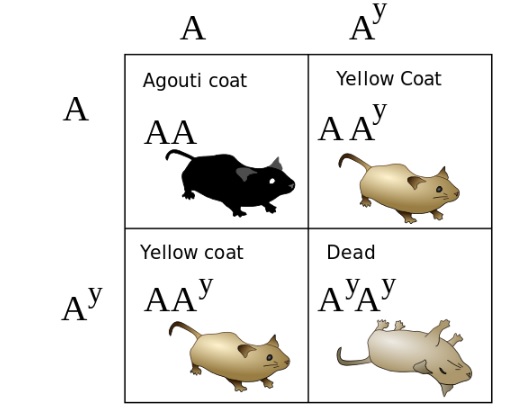
| Coat Color | Alelle | Inheritance Pattern |
| Agouti | C | dominant to other alleles |
| Black | c^b | dominant to albino |
| Albino | c | recessive |
- Coat color in mice depends on three alleles. A scientist crosses a black mouse (c^bc) with an agouti mouse (Cc^b) What are the predicted phenotypes of their offspring?
- 50% of the offspring will have agouti coats and 50% will have black coats
- 2/4 offspring will have agouti coats (either Cc^b or Cc) and 2/4 offspring will have black coats (either c^bc^b and c^bc.
- c^bc * Cc^b cross will produce
- ¼ Cc^b offspring
- ¼ Cc offspring
- ¼ c^bc^b offspring
- ¼ c^bc offspring
- 50% of the offspring will have agouti coats and 50% will have black coats
- Human eye colors are found on a spectrum that ranges from completely pigmented (dark brown eyes) to a complete lack of pigment (light blue eyes). Which type of non-Mendelian inheritance does human eye color exemplify and why?
- Polygenic inheritance;
- it involves multiple genes coding for a trait that falls within a wide spectrum
- Since a polygenic trait is controlled by multiples genes, eye color is a good example because it greatly varies between a variety of colors that don’t fall into distinct and singular phenotypes.
- The fact that there are many intermediates that can widely range between the two ends of the spectrum indicates that the trait can’t simply have just one intermediate phenotype.
- Polygenic inheritance;
- Both pleiotropy and polygenic inheritance are key examples of Non-Mendelian inheritance. Which of the following answer choices is true?
- Pleiotropy is when one gene affects multiple characteristics (e.g. Marfan syndrome).
- This is true because the multiple symptoms of Marfan syndrome (unusually tall height, thin fingers/toes, lens dislocation, heart problems) are related to a single gene mutation.
- While polygenic inheritance would refer to the inheritance of a complex trait (e.g. height, skin pigmentation) controlled by many genes (not one).
- Pleiotropy is when one gene affects multiple characteristics (e.g. Marfan syndrome).
Chromosome number and structure:
- Which of the following statements are true about the homologous chromosomes of a pair?
- They usually have the same genes at the same relative locations.
- Homologous pair have the same genes at the same location (loci), but will possibly have different alleles.
- They usually have the same genes at the same relative locations.
- The image above represents a diploid (2n) cell from a swamp wallaby. Based on the image and the information above, which of the following statements are true?
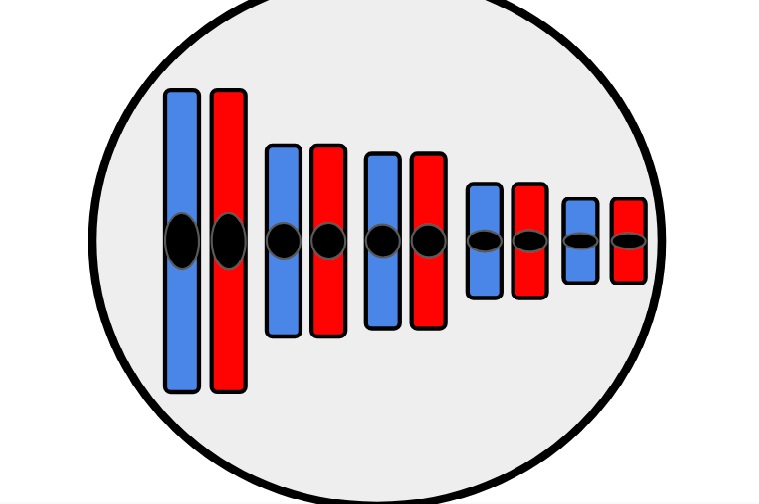
- There are 5 homologous pairs of chromosomes in the cell.
- There are 5 blue chromosomes and 5 red chromosomes, each paired with each other according to their size. Each color represents one set from each parent, totaling to 10 total chromosomes amongst 5 homologous pairs.
- The haploid (n) number of this cell is 5 (n=5)
- Since the diploid (2n, 2 sets) number of this cell is (2n=10) we know that in order to be haploid (n, 1 set), there would be half as many total chromosomes for a value of n=5.
- The image above represents a haploid (n) cell from a swamp wallaby. Based on the image and the information above, which of the following statements are true?
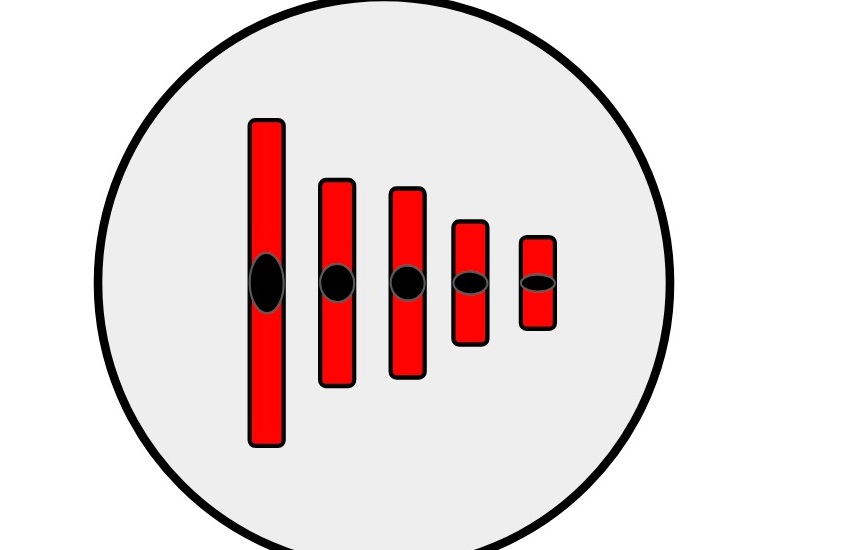
- There are no homologous pairs of chromosomes in the cell.
- Since we’re told that the cell is haploid (n), we can assume that none of these chromosomes have a homologous pair. Haploid (n) cells only have one set of chromosomes.
- The diploid (2n) number of this cell is 10 (2n=10)
- A diploid (2n) cell in this organism would contain two sets of genetic information, resulting in 5 pairs of homologous chromosomes. This would equate to 2n=10 resulting in 10 total chromosomes amongst two sets (maternal & paternal).
- Which of the following statements are true about sister chromatids?
- They are tightly connected at the centromere.
- Sister chromatids connect at the centromere by proteins called cohesins.
- They are tightly connected at the centromere.
- The haploid cells of a kangaroo contain 8 chromosomes. How many chromosomes are in a kangaroo’s diploid cells?
- 16
- Diploid cells contain twice the number of chromosomes of haploid cells.
- 16
Mitosis:
- What must this cell do before it can carry out mitosis? (The cell has a diploid number of 4 chromosomes; 2n = 42.
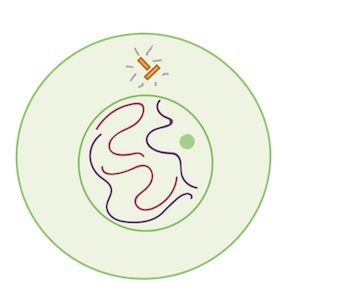
- Replicate its DNA
- Each chromosome is present as a single chromatid, and the chromosomes must be copied before they are split up in mitosis
- Duplicate its centrosome
- The cell still has only one centrosome, and will need two to serve as poles of the spindle
- This cell is in which stage of mitosis –
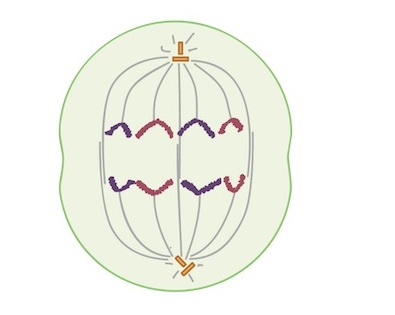
The chromosomes are separating to opposite poles of the cell, but the nuclei have not yet begun to re-form.
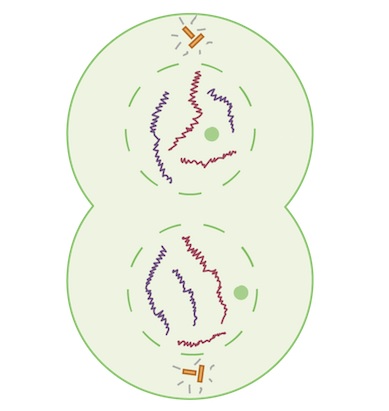
- Telophase – The two daughter nuclei are beginning to form, the nucleoli have reappeared, and the chromosomes are beginning to decondense.
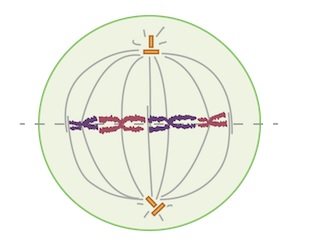
- What is the name of the plane marked by the dotted line?
- The metaphase plate is the plane in which the chromosomes align during metaphase.
- How many chromosomes are shown in this picture? How many chromatids?
- 4 chromosomes, 8 chromatids
- There are four chromosomes, and each consists of two sister chromatids.
- 4 chromosomes, 8 chromatids
- The chromosomes have already separated, and the daughter nuclei have started to form.
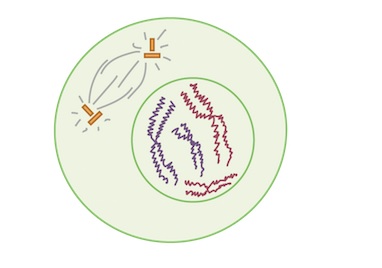
- The chromosomes are beginning to condense and the spindle has begun to form, but the nuclear envelope has not yet broken down.
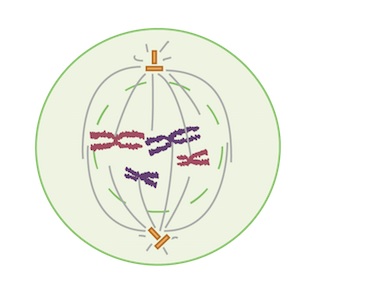
- The nuclear envelope has broken down, and the spindle microtubules have begun to capture chromosomes.
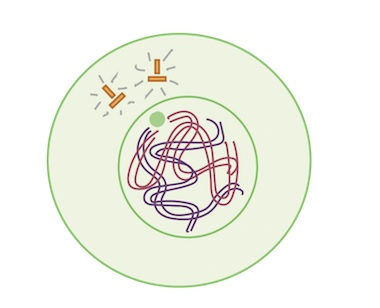
- The cell has duplicated its centrosomes and DNA, but has not yet entered mitosis (chromosomes are decondensed and nucleolus and nuclear membrane are intact).
- Something’s wrong with this picture! What might explain the unusual pattern seen in this cell?
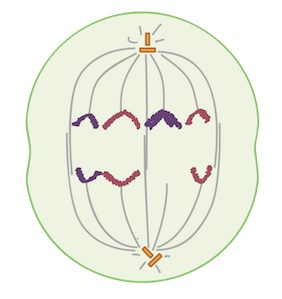
- During metaphase, one of the chromosomes failed to bind microtubules from both spindle poles.
- If a chromosome is only connected to the spindle by a single kinetochore, the sister chromatids may not separate correctly during anaphase.
The cell cycle and mitosis:
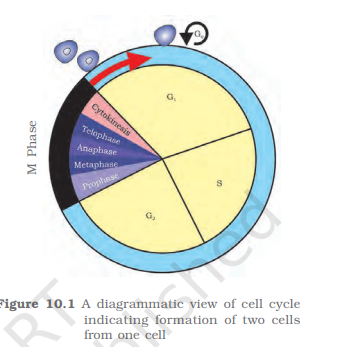
- Which of the following shows the correct sequence of the stages in mitosis (left to right)
- Prophase →Metaphase →Anaphase →Telophase
- Which stage of the cell cycle contains the G1, S, and G2 phases?
- Interphase
- Interphase occurs between mitotic cycles and contains two gap phases and one synthesis phase (S). During interphase, the cell grows and makes a copy of its DNA.
- Interphase
- Palbociclib is a cancer drug that targets cells which no longer follow the normal rules and regulations of the cell cycle. Which of the following best describes a possible mechanism for how Palbociclib may function?
- Palbociclib blocks the passage through an early cell cycle checkpoint.
- Palbociclib specifically blocks the G_1 checkpoint of the cell cycle, which means that all the phases thereafter (S, G_2 mitosis) won’t occur, so the cancer cells won’t be able to grow and divide.
- Palbociclib blocks the passage through an early cell cycle checkpoint.
- In humans, adult brain cells called neurons are terminally differentiated. This means that they are completely mature and no longer undergo the cell cycle. Which of the following statements best describes how the cell cycle relates to neurons?
- Neurons do not go through M phase.
- Since adult neurons are in G0 phase, they no longer undergo the phases of the cell cycle and instead, go through their typical cell functions outside of cell division.
- Neurons do not go through M phase.
- UV radiation can directly cause the DNA within cells to mutate, which may eventually lead to the formation of cancer. Which of the following best describe mechanisms for how UV radiation may lead to cancer?
- UV radiation may cause positive regulators (oncogenic) to be over-expressed.
- If there’s too much expression of positive regulators (oncogenic), there would be too much cell growth and division, a characteristic sign of cancer.
- UV radiation may cause negative regulators (tumor suppressors) to be under-expressed.
- If there’s not enough expression of negative regulators (tumor suppressors), there would be less tumor suppression, meaning that the likelihood of a tumor (and cancer) developing dramatically increases.
- UV radiation may cause positive regulators (oncogenic) to be over-expressed.
- Which of the following is true of interphase?
- Interphase is longer than the mitotic phase.
- Interphase is much longer than mitosis. In fact, many eukaryotic cells spend most of their lives in interphase.
- Interphase is longer than the mitotic phase.
Meiosis:
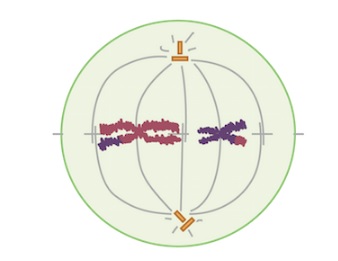
- During metaphase II, individual chromosomes line up in the center of the cell along the equator, also known as the “metaphase plate.”
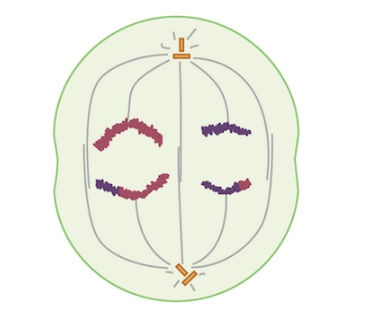
During anaphase II, the sister chromatids separate and are pulled to opposite poles of the cell.
| Prophase I | Metaphase I | Anaphase I | Telophase I | |
| Homologue pairs line up in the center of the cell. | yes | |||
| Chromosomes arrive at opposite poles of the cell and the nuclear membrane reforms. | yes | |||
| Homologue pairs pull apart and move to opposite ends of the cell. | yes | |||
| Crossing over occurs. | Yes |
- When does crossing over occur during meiosis?
- Prophase I
- Crossing over occurs during prophase I of meiosis. It increases genetic diversity of eggs and sperm by exchanging pieces of DNA between homologues, making new gene combinations.
- Prophase I
- During meiosis, a process known as crossing over occurs. Which of the following is true of crossing over?
- A chiasma indicates that a crossover has occurred.
- A chiasma (plural: chiasmata) is the cross-shaped structure that links homologues together. This is the location where these non-sister chromatids can trade their genetic information.
- A chiasma indicates that a crossover has occurred.

Recent Comments